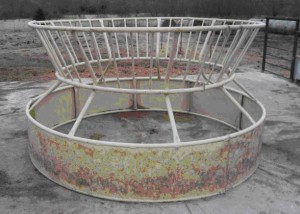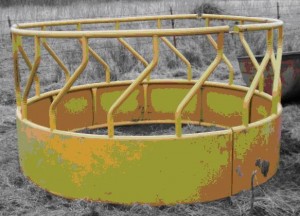– David Lalman, Austin Sexten, Gant Mourer, Casey McMurphy and Chelsea Dobbs; Oklahoma State University
This year’s (2011) historical drought has forced cattle producers in the Southern Great Plains to liquidate cattle or withstand record high purchased and harvested feed prices. Additionally, where the typical winter hay feeding season lasts for 90 to 120 days, many cow/calf operations that have chosen to retain part or all of the cow herd will be forced to feed for 200 days or more. Like never before, this is the winter feeding season to consider methods to improve efficiency of harvested forage use. Fortunately, a few relatively simple concepts are available that could make a dramatic impact. In fact, when combined, these strategies could cut the need for hay by at least one third!
Limiting hay intake: Feed yards and backgrounding operations have taken advantage of improved efficiencies associated with limit feeding growing cattle for many years. This strategy could be used to substantially reduce hay use in cow/calf operations as well. By limiting forage intake, forage digestibility should increase and waste should go down. Minnesota and Illinois researchers limited the amount of time cows had access to hay. When cows were allowed access to hay for six hours, hay intake was reduced by an average of 22% over three experiments (Table 1). Hay waste was reduced with restricted access in two of the three experiments and cow weight gain declined with restricted access in all three experiments. Note that cows with restricted access gained weight in all three of the experiments, even though they did not gain as much as cows with ad libitum access. This suggests that initial cow body condition and hay quality may be important factors in successful implementation of this strategy. For example, if cows are in poor body condition initially, or if hay quality is extremely low, cow performance, newborn calf health and reproductive efficiency could be compromised.
Estimating ad libitum intake and determining the degree of restriction below ad libitum intake are critical factors in using the limit feeding strategy. The National Research Council publishes equations to estimate forage intake and these equations are incorporated into many cow/calf nutrition evaluation software programs. For example, OSU Cowculator uses cow size, stage of production, milk yield and forage quality to estimate dry matter intake. Cowculator (and many other nutrition evaluation programs) can also be used to estimate performance of cows with varying degrees of hay restriction. Cowculator is available at beefextension.com. Limit feeding is not recommended for first calf heifers or thin, older cows.
Table 1. Effects of restricted or ad libitum access to hay on hay intake, hay waste and cow weight change
| 6 HR | 24 HR | Difference, % | |
| Exp 1a | |||
| Hay DM Intake, lb | 21.2 | 24.4 | 22.6 |
| Hay DM waste, % | 0.8 | 7.7 | 89.6 |
| Cow BW change, lb | 27.3 | 51.2 | 46.7 |
| Exp 2b | |||
| Hay DM Intake, lb | 24.5 | 34.2 | 28.4 |
| Hay DM waste, % | 23.2 | 39.5 | 41.3 |
| Cow BW change, lb | 161 | 207 | 22.2 |
| Exp 3c | |||
| Hay Intake, lb | 23.6 | 28.4 | 16.9 |
| Hay DM waste, % | 16.1 | 16.4 | 1.8 |
| Cow BW change, lb | 141 | 168 | 16 |
| a Adapted from Jaderborg et al., 2011 | |||
| b Adapted from Miller et al., 2007 | |||
| c Adapted from Miller et al., 2007 | |||
Using hay feeders designed to limit hay waste: Our group at Oklahoma State recently studied the effects of hay feeder design on hay waste. Two feeders with open bottoms and two feeders with sheeted bottoms were evaluated (Figures below). The open bottom feeders wasted an average of 21% of the original bale weight. These two feeders are light weight, convenient to use and inexpensive. Consequently, they are the most popular feeder style being used in the state of Oklahoma. The sheeted (solid) bottom feeder reduced hay waste to 13%. However, a modified cone feeder with a sheeted bottom reduced hay waste to only 5%. The feeders with sheeted bottoms are both heavier and more expensive than the open bottom feeders. Nevertheless, assuming hay valued at only $120 per ton and a 120-day feeding period, the difference in the value of one feeding season’s hay waste between the open bottom steel ring feeder and the modified cone feeder is $468.72. Few cow/calf operations will be able to absorb the cost of 21% hay waste when hay is extremely valuable.
Figure (a) Above: modified cone feeder with sheeted bottom
Figure (b) Above: conventional open bottom steel ring feeder
Figure (c) Above: polyethylene pipe open bottom ring feeder
Figure (d) Above: sheeted bottom steel ring feeder
Using an Ionophore: The use of an ionophore for grazing cattle and cattle consuming hay can increase the energy value of a forage diet and thus further reduce the need for hay. Older research has shown that Rumensin and Bovatec improves weight gain of growing cattle. Rumensin is approved for the use in mature beef cows. Older research showed that Rumensin reduced hay intake by around 10% while still producing about the same amount of weight gain (Turner et al., 1980; Clanton et al., 1981). In a recent study in our shop at OSU, cows fed 200 mg of Rumensin gained an additional 0.5 per head per day and nearly one half a body condition score unit more during a 58 day study. Importantly in this project, the forage digestibility was improved dramatically, resulting in the improved cow performance. One could look at the addition of Rumensin in the supplement as having increased the net energy value of this low quality hay diet by about 15%. In other words, less of the same diet (hay) would need to be fed to get the same performance. In our region, the cost of Rumensin is about $0.02 per cow per day. I don’t know any other way to get that much improvement in forage utilization at such a low cost. There is a reason why the cattle feeding industry has been using this feed technology so extensively for so long, and a substantial improvement in feed efficiency is that reason. The same technology and benefits are available to the cow/calf industry, although it is highly underutilized.
Research is not available evaluating the potential hay savings when two or more of these technologies are combined. Nevertheless, it is very possible that hay use could be reduced by 30 to 40% when two or all three of these strategies are implemented.
Clanton, D.C., M.E. England, and J.C. Parrott III. 1981. Effect of Monensin on efficiency of production in beef cows. J ANIM SCI 53:873-880.
Jaderborg, J. P., G. I. Crawford, and A. DiCostanzo. 2011. Access time to hay feeder by gestating beef cows affects dry matter intake and hay waste. 2011 University of Minnesota Beef Report Publication BR-1103. Available: http://www.ansci.umn.edu/beef/2010-11%20MN%20BEEF/files/research_reports/BR1103-Jaderborg.pdf.
Miller, A. J., D. B. Faulkner, T. C. Cunningham, and J. M. Dahlquist. 2007. Restricting time of access to large round bales of hay affects hay waste and cow performance. Prof. Anim. Sci. 23:366-372.
Turner, H.A., D.C. Young, R.J. Raleigh, and D. ZoBell. 1980. Effect of various levels of Monensin on efficiency and production of beef cows. J ANIM SCI 50:385-390.
EDITOR’s NOTE: The Noble Foundation put together an on-line calculator based on a spreadsheet that was built after the Oklahoma State project with the different feeders was completed. The numbers produced by the calculator, which are based on the waste data from the project, exhibit just how much a change in feeder design can save/cost a beef cattle operation. The Noble Foundation calculator is linked here.



